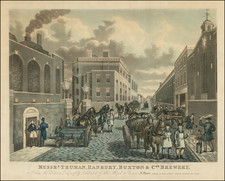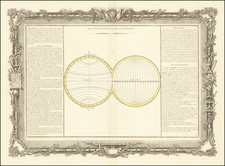Unusual portrait of Charles Lindbergh on linen, which was apparently intended a a do-it-yourself sampler.
The item shows a pattern intended for embroidery, but only the left side of the Lindbergh's suit jacket has been stitched with black and blue yarn.
Rarity
We were unable to locate other examples.
Lindbergh, a Complicated Figure
Lindbergh's life journey took him from being one of the most adored men in the US to being nearly universally despised in less than two decades. His rise to fame was rapid and sharp. He was trained as a mail pilot but decided he wanted to pursue the Orteig Prize, a twenty-five thousand dollar reward for the first successful solo nonstop flight between Paris and New York. The competition was fierce, with many more experienced pilots having tried and failed.
Lindbergh managed to scrape together funds to finance his voyage, and he built his Spirit of St. Louis in San Diego in the beginning of 1927. He proceeded to fly it from New York to Paris in 33 and a half hours, thus winning the prize at the age of 25. He was given a hero's welcome in Paris with universal acclaim. That same year he became Time's first Man of the Year and lived off of the fame for the next several years.
The first major downturn in Lindbergh's life would be the kidnapping of Charles Lindbergh Jr. The Lindbergh kidnapping, widely and possibly accurately claimed to be the "Crime of the century," once again brought Lindbergh to the center of attention. The public followed the developments of this story for the next two years and the ordeal had a large impact on Lindbergh.
The final major chapter in Lindbergh's life was, of course, his involvement in the America First Committee. Officially a nonintervention movement, it, and particularly his involvement, had anti-semitic undertones. He made several statements that appeared to place him as a white supremacist and Nazi sympathizer. The public and the Roosevelt administration were particularly displeased with his anti-war stance, which was viewed as non-patriotic.
Lindbergh eventually joined the war effort as a civilian, working as an engineer throughout the South Pacific and even conducting bombing missions. Later in his life, he appeared to walk away from some of his more racist views and focused much of his time on environmental causes.









![[King George II] George de Tweede, Koning van Groot Britannie Frankryk, Ierland enz.](https://storage.googleapis.com/raremaps/img/small/83655.jpg)
![[Signed Political Satire Artwork] Vietnam ... Vietnam ... Vietnam ...](https://storage.googleapis.com/raremaps/img/small/68726.jpg)


![[ Game Board World Map -- Gulf of Korea named ] Walker's Geographical Pastime Exhibiting a Complete Voyage Round the World in Two Hemisphere with Tetotum, Pillars & Counters, for Playing This Highly Interesting Game.](https://storage.googleapis.com/raremaps/img/small/102691.jpg)
![[The centre of this Slider is to be placed by a Thread or Pin over the centre of the respective Planisphere for any Operation]](https://storage.googleapis.com/raremaps/img/small/65557.jpg)